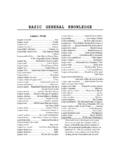Transcription of The Optical Industry in India Market Research - Italy india
1 The Optical Industry in India Market Research Istituto nazionale per il Commercio Estero L Istituto nazionale per il Commercio Estero, con la propria rete di Uffici nel mondo e con le attivit di promozione e di assistenza, costituisce un osservatorio sui mercati internazionali al servizio delle imprese italiane. La presente pubblicazione rientra nel programma editoriale dell Istituto - collana PROFILI/PRODOTTO/MERCATO - ed stata realizzata nell ambito del Programma Promozionale finanziato dal Ministero del Commercio Internazionale - a cura dell Ufficio ICE di New Delhi.
2 Il programma editoriale curato dall Area Prodotti Informativi Editoria Elettronica. Giugno 2008 Copyright Istituto nazionale per il Commercio Estero India Il settore dell ottica Istituto nazionale per il Commercio Estero Table of Contents 1. 2. India - Brief Economic 3. Overview of Global Optical Overview and Market 4. Optical Sector in Principal Market Market Characteristics ..6 Leading Players ..6 Italian Presence ..7 Production Dependence on Imports ..8 5. Structure of Trade & Types of Distribution Trade Commercial Terms.
3 9 6. Regulatory Investment and Trade Regulations ..10 Taxes and Labeling and Marking Rules ..11 Documents required for custom clearance in 7. Opportunities for Italian Companies in India in general ..11 Optical Sector ..12 Istituto nazionale per il Commercio Estero India : Il settore dell ottica 1 1. Introduction Italian Trade Commission (ICE), Trade Promotion Section of the Italian embassy , New Delhi, has appointed Ace Global Private Limited, a consultancy company based in New Delhi, to undertake the Market Survey on India s Opticals sector, focusing on ophthalmic lenses and related products like sunglasses, spectacle frames etc.
4 The main objective of the study is to identify potential business opportunities for Italian companies in the sector based on insights into the Indian Optical Industry , especially with regard to the current state of the sector in India , principal factors driving the growth of the Market , regulatory and other influences and external trade trends etc. This report summarizes the key findings of the study, which was based on extensive secondary Research and primary Research covering important manufacturers, importers/distributors and retailers. 2. India - Brief Economic Scenario India is a large country with total area of million sq. km., sharing land border with six countries, and a long coastline of 7,000 km.
5 The country is a federation of 29 states and 6 union territories (administrative units). India s total population is billion ( Italy million), growing at per annum. There are 5 major religions and the overall literacy level is There are 14 officially recognized languages. Hindi is the most used language. English is widely used in business as well as in everyday life. Economic Trends: India is among the fastest-growing economies in the world, with close to 8% annual growth since 2002, and expected to be sustained for the next 5 years as well. Inflation rate remained below 5% between 2001 to 2007, but has since increased, touching in May 2008.
6 The business regulatory environment is fairly open, and follows free- Market competition principles. All quantitative restrictions on trade were removed in 2001, except for a few highly sensitive goods. Trade as a % of GDP has risen from 13% in 1991 to nearly in 2005-06. The total cumulative foreign direct investment (FDI) received into India up to March 2007 was US$ billion, of which Italy s share is about The monetary unit of India is Indian Rupee (1 Indian Rupee = 100 paise). The exchange rate of Indian Rupee is Euro 1 = Rs. and US$ 1 = Rs. (March 2008 - Reserve Bank of India ). Istituto nazionale per il Commercio Estero India : Il settore dell ottica 2 Demographics: India is a unique Market on account of its diversity in age, income, and urban-rural demographics.
7 Nearly 58 million households, comprising of India s dwelling units, live in urban areas. Nearly 38% of urban households are in middle and higher income strata, and only 14% of rural households have similar income levels. Income Classification: Even though the population is more than billion, the real consuming class of 300 million people outnumbers several of the world s large markets in terms of Market potential. Of these, around 150 million people (2 million very rich and 30 million rich households) represent the consuming potential, particularly for lifestyle goods and services. There are close to 80,000 high net worth Individuals in India , with saving and assets exceeding US$1 million.
8 At least 50,000 households buy premium cars every year (priced at US$ 30,000 and above). The Market for luxury goods is estimated to be Rs 100 billion, with over 2 million Indians estimated to be engaging in some luxury purchase or the other each year. Main Cities: Mumbai, Kolkata, Delhi, Hyderabad and Chennai are the most populated and wealthiest cities, closely followed by Bangalore, Ahmedabad, Pune, Vadodara and Kanpur. The top seven cities Mumbai, Delhi, Chennai, Kolkata, Hyderabad, Ahmedabad and Bangalore, together have over 6 million homes falling in the upper socio-economic strata. Age-group distribution: India is a very young nation with 85% of its population below the age of 45, and 55% of its people below 25 years of age.
9 Young adults, the group between 20 and 35 years, represent nearly 25% of the consumer base in the country, and drive consumer and lifestyle trends. Health & Vision Care indicators: Life expectancy at birth Male/Female (years) : Total health expenditure per capita (2003): US$82 ( of GDP) 360 million Indians above the age of 35 need near vision correction [for reading]. 386 million Indians require spectacles every year (NOA) Average rate of spectacles replacement 3 years Due to the geographical location of India and global warming very large number of people require protection from harmful UV rays of the sun. 3. Overview of Global Optical Industry Overview and Trends The demand is driven by demographics, fashion, and changing healthcare practices.
10 Aging population is increasing the demand for eye exams and glasses. Istituto nazionale per il Commercio Estero India : Il settore dell ottica 3 Eye care has evolved from age-related vision disorders to cosmetic concerns. Spectacles are nowadays considered as personality enhancers and a fashion accessory. Changing lifestyles and activities that affect the eyes, have led to increasing use of colored contacts, tinted spectacle lens, polycarbonate lenses with anti glare and photo chromatic lenses. This has been further aided by introduction of daily, weekly, and monthly disposable contact lenses.







